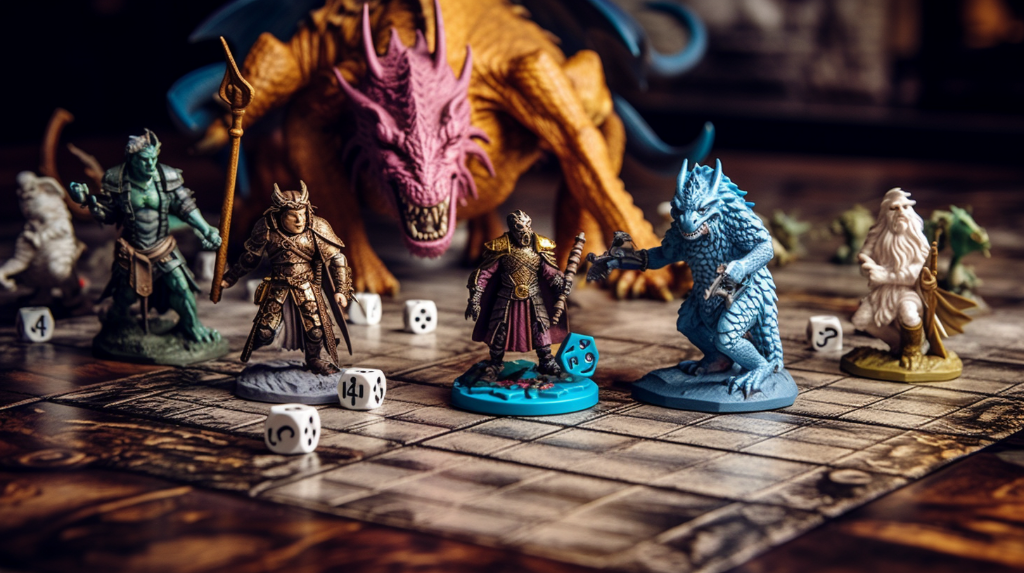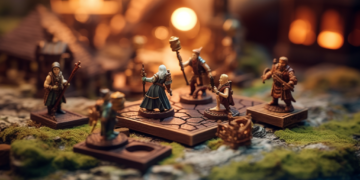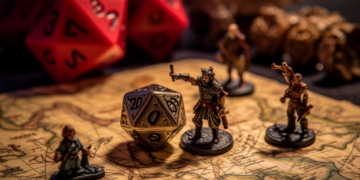
Imagine standing on the edge of a dense forest, your heart pounding with anticipation as the rustling leaves whisper tales of the hidden creatures within. In the world of Dungeons & Dragons, such mystical encounters are not merely figments of imagination, but a reality waiting to unfold. One such enchanting element is the ability to speak with animals. A magical essence throbs within the heart of every D&D player who can converse with creatures of the wild, bridging the gap between humanity and nature. This compelling ability is not just a mere trick up a druid’s sleeve, but a key that opens up a world full of untamed wonder and unspoken wisdom.
Unlocking the Spell: Speak with Animals
So, how does one tap into the primal language of beasts? The answer lies in the spell ‘Speak with Animals’. This spell isn’t just another entry in your spellbook; it’s a doorway to understanding the silent whispers of the wild. It requires you to reach level 1, and the components? Merely a pinch of fur and a feather. The process of casting this spell is a dance between the player and the arcane, with verbal and somatic movements weaving the magic into existence.
But what does it feel like, you ask? Imagine the thrill of decoding a secret language, the joy of understanding a foreign tongue. Casting ‘Speak with Animals’ is akin to unlocking a secret code, a code that has been whispered by the wind, growled by bears, and chirped by birds since the dawn of time.
The Role of Speak with Animals in Gameplay
But how does ‘Speak with Animals’ fit into the grand scheme of your D&D adventure? Well, it’s not just about understanding what the crow caws or the wolf howls. It’s about strategizing, about using this newfound understanding to your advantage.
Has a mischievous sprite hidden a vital artifact? Perhaps a conversation with a squirrel could lead you to it. Is a beast blocking your path? Maybe a diplomatic dialogue with it could resolve the conflict. The possibilities are as vast as the animal kingdom itself.
And let’s not forget the role-playing element. Engaging with a griffon or trading riddles with a sphinx can add layers to your character’s persona and depth to your storyline. So, are you ready to unlock the untamed wisdom of the wild?
Delving Deeper: The Language of Animals
Imagine the whispers of the woodland creatures, the chatter of birds, and the growls of beasts turning into coherent words and sentences. This is the wonder that the ‘Speak with Animals’ spell brings to life. In the vibrant, fantastical realms of D&D, where the extraordinary is the norm, this spell allows player characters to bridge the chasm between man and beast, to comprehend and converse with the creatures of the wild. But what does it mean to speak the language of animals?
In essence, the ‘Speak with Animals’ spell transforms the guttural sounds, the intricate body gestures, and the primal instincts of beasts into a language that the caster can understand and respond to. It’s a symphony of nature translated into words, a melody of mutual understanding that transcends species.
But it’s not just about words and sentences. It’s about the emotions, the fears, the joys, and the instincts that lie beneath them. It’s about perceiving the world from the eyes of a beast, feeling the pulse of the wilderness in each phrase, and getting lost in the profound simplicity of their thoughts. Isn’t it a fascinating prospect?
Understanding Beasts: A New Perspective
Speaking with animals can be more than a tool; it can be a gateway to a new perspective. As a character begins to communicate with beasts, they start to see the world through a different lens—a lens that reveals the truths of nature, the wisdom of the wild, and the raw beauty of life untamed. They begin to realize that every creature, no matter how small or insignificant, has a voice worth hearing, a story worth telling.
Imagine understanding the fears of a rabbit, the pride of a lion, or the freedom of a bird. Imagine feeling the pulse of the wilderness in each conversation, unraveling the mysteries of nature one beast at a time. In the grand scheme of adventures, battles, and quests, these moments of connection can add a unique flavor to your character’s journey. But are there any misconceptions about this magical ability?
Misconceptions About Speaking with Animals
While the ‘Speak with Animals’ spell can open doors to fascinating interactions, it’s important to remember that it doesn’t turn beasts into obedient pets or loyal allies. Animals, like any other creatures in D&D, have their own instincts, temperaments, and behaviors. The spell does not alter these fundamental traits; it merely provides a channel of communication.
Moreover, the spell doesn’t grant you the ability to command animals or persuade them against their nature. A wolf will remain a predator, a deer will still be skittish, and a bird will continue to cherish its freedom. The spell merely allows you to converse with them, to understand their thoughts and express yours. It’s a tool for communication, not control. Don’t you think it makes the game more intriguing?
Practical Applications of Speak with Animals
Have you ever considered the strategic possibilities that the ‘Speak with Animals’ spell offers in the grand tapestry of D&D gameplay? The spell’s practical applications extend far beyond just casual conversation with woodland creatures. Its influence can ripple out, affecting combat, exploration, and character interactions.
In the heat of battle, speaking with animals can provide a unique tactical advantage. A swarm of bats in a cave, for instance, can be persuaded to create a disorienting cloud, providing your party with the upper hand. Imagine the surprise of your foes when nature itself seems to rise against them!
When it comes to exploration, the local fauna can often prove to be far more knowledgeable about their environment than any map. A bird’s-eye view of the terrain, or the whispered secrets of a forest from a deer, can provide invaluable information that could mean the difference between a successful quest and an untimely end.
The spell also opens up unique opportunities for interaction. Can you imagine negotiating with a griffon for safe passage, or convincing a pack of wolves to aid you in tracking down a fleeing enemy? The possibilities are as vast as the wilderness itself.
The Limitations of Speak with Animals
While the ‘Speak with Animals’ spell can be a powerful tool in the hands of a clever player, it does come with its limitations. The most notable one is the spell’s duration. Remember, the spell only lasts for ten minutes, a mere drop in the ocean of time in a D&D campaign. This calls for careful timing and precision in its use.
Another limitation to consider is the intelligence of the animal you’re communicating with. Not all beasts are created equal in the realm of intellect. A crow may be able to provide complex information, while a toad might only be able to communicate basic concepts. Understanding this can help you choose your animal allies wisely.
Overcoming the Limitations
Despite these limitations, there are several ways to maximize the effectiveness of ‘Speak with Animals’. Teaming up with other characters, for example, can greatly enhance the spell’s utility. A bard’s ‘Enhance Ability’ spell can boost an animal’s intelligence, making them a far more valuable source of information.
The true magic of D&D lies in creativity. An inventive player can often find ways around these limitations, turning them into opportunities for memorable role-playing moments. So, are you ready to turn the tables on these limitations?
| Animal | Intelligence | Communication Effectiveness |
|---|---|---|
| Owl | 2 | Basic |
| Wolf | 3 | Moderate |
| Sphinx | 16 | Advanced |
| Griffon | 2 | Basic |
| Unicorn | 11 | High |
The Art of Speaking with Animals
Speaking with animals is not just a mere spell, it’s a form of art, a dance between two minds that are inherently different, yet find a way to connect through the magic of D&D. It is more than just words; it’s about body language, tone, and understanding. Isn’t that what communication is truly about?
When you cast ‘Speak with Animals’, envision the magic wrapping around you, forming an ethereal link between you and the beast. Picture their thoughts and feelings flowing into you as your own seep into them. Feel the thrill of your mind expanding to comprehend a language so different from your own. It’s not just speaking—it’s understanding, empathizing, and connecting.
Remember, the more immersive and theatrical you make this process, the more rewarding it will be. Use vivid descriptions to portray your character’s attempts to communicate with the animal. Play up the struggle of trying to understand an alien mindset. Celebrate the triumph when understanding is reached. This is your moment to shine as a role-player.
Final Thoughts: Speak with Animals as a Reflection of D&D’s Magic
At its core, ‘Speak with Animals’ is a reflection of the enchanting world of D&D, a game where magic is as real as the air we breathe, and the impossible becomes possible. This spell is a bridge between species, a testament to the game’s infinite possibilities. It challenges you, stretches your imagination, and rewards you with unique interactions and experiences.
So, why not embrace the challenge? Why not take the leap and discover what it feels like to gaze into the eyes of a beast and understand the thoughts swirling within? Isn’t that the essence of D&D’s magic? The freedom to explore, to push boundaries, and to experience a world where anything is possible?
In the end, ‘Speak with Animals’ is more than a spell. It’s a journey, a story, and a testament to the magic of D&D. Embrace its challenges, revel in its rewards, and let it add another layer of depth to your gameplay.
- Practice makes perfect: Don’t be discouraged if your initial attempts to use the spell don’t go as planned. Keep trying, and with time, you’ll get the hang of it.
- Use it creatively: Remember, the spell doesn’t just allow you to talk to animals—it allows you to understand them. Use this to your advantage in a variety of ways.
- Role-play is key: Make the spellcasting process as immersive as possible. It will not only make the game more fun but also make your character more compelling.
- Don’t underestimate the power of teamwork: If you’re having trouble with a particular beast, don’t hesitate to ask for help from your party. Together, you can achieve much more than you could alone.
- Respect the animals: Just because you can speak with them doesn’t mean they’re at your beck and call. Treat them with respect, and they’re more likely to respond positively.






